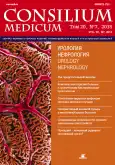Assessment of measured in multiparametric magnetic resonance imaging diffusion coefficient potential for low malignancy score determination in PC after radical prostatectomy
- Authors: Goncharuk D.A1, Veliev E.I1,2, Sokolov E.A1,2, Shabunin I.V3, Paklina O.V2, Setdikova G.R2
-
Affiliations:
- Russian Medical Academy of Continuous Professional Education of the Ministry of Health of the Russian Federation
- S.P.Botkin City Сlinical Hospital of the Department of Health of Moscow
- Medical and diagnostic center “Patero-Clinic”
- Issue: Vol 20, No 7 (2018)
- Pages: 15-19
- Section: Articles
- URL: https://journals.rcsi.science/2075-1753/article/view/94969
- DOI: https://doi.org/10.26442/2075-1753_2018.7.15-19
- ID: 94969
Cite item
Full Text
Abstract
Full Text
##article.viewOnOriginalSite##About the authors
D. A Goncharuk
Russian Medical Academy of Continuous Professional Education of the Ministry of Health of the Russian Federation
Email: gonch.urology@yandex.ru
аспирант, ст. лаборант каф. урологии и хирургической андрологии 125993, Russian Federation, Moscow, ul. Barrikadnaia, d. 2/1
E. I Veliev
Russian Medical Academy of Continuous Professional Education of the Ministry of Health of the Russian Federation; S.P.Botkin City Сlinical Hospital of the Department of Health of Moscowд-р мед. наук, проф. каф. урологии и хирургической андрологии 125993, Russian Federation, Moscow, ul. Barrikadnaia, d. 2/1; 125284, Russian Federation, Moscow, 2-i Botkinskii pr-d, d. 5
E. A Sokolov
Russian Medical Academy of Continuous Professional Education of the Ministry of Health of the Russian Federation; S.P.Botkin City Сlinical Hospital of the Department of Health of Moscowассистент каф. урологии и хирургической андрологии; врач-уролог 14-го урологического отд-ния 125993, Russian Federation, Moscow, ul. Barrikadnaia, d. 2/1; 125284, Russian Federation, Moscow, 2-i Botkinskii pr-d, d. 5
I. V Shabunin
Medical and diagnostic center “Patero-Clinic”зав. отд-нием лучевой диагностики, врач-рентгенолог 129226, Russian Federation, Moscow, pr. Mira, d. 211, k. 2
O. V Paklina
S.P.Botkin City Сlinical Hospital of the Department of Health of Moscowзав. патологоанатомическим отд-нием 125284, Russian Federation, Moscow, 2-i Botkinskii pr-d, d. 5
G. R Setdikova
S.P.Botkin City Сlinical Hospital of the Department of Health of Moscowврач-патологоанатом 125284, Russian Federation, Moscow, 2-i Botkinskii pr-d, d. 5
References
- Epstein J.I, Allsbrook W.C, Amin M.B, Egevad L.L. The 2005 International Society of Urological Pathology (ISUP) Consensus Conference on Gleason Grading of Prostatic Carcinoma. Am J Surg Pathol 2005; 29: 1228-42.
- Ahmed H.U, Arya M, Freeman A et al. Do low-grade and low-volume prostate cancers bear the hallmarks of malignancy? Lancet Oncol 2012; 13 (11): e509-17.
- Musunuru H.B, Yamamoto T, Klotz L et al. Active surveillance for intermediate risk prostate cancer: survival outcomes in the Sunnybrook experience. J Urol 2016; 196 (6): 1651-8.
- Epstein J.I, Zelefsky M.J, Sjoberg D.D et al. A contemporary prostate cancer grading system: a validated alternative to the Gleason score. Eur Urol 2016; 69 (3): 428-35.
- Epstein J.I, Feng Z, Trock B.J, Pierorazio P.M. Upgrading and downgrading of prostate cancer from biopsy to radical prostatectomy: incidence and predictive factors using the modified Gleason grading system and factoring in tertiary grades. Eur Urol 2012; 61: 1019-24.
- Oto A, Kayhan A, Jiang Y et al. Prostate cancer: differentiation of central gland cancer from benign prostatic hyperplasia by using diffusion-weighted and dynamic contrast-enhanced MR imaging. Radiology 2010; 257: 715-23.
- Litjens G.J.S, Hambrock T, Hulsbergen-van de Kaa C et al. Interpatient variation in normal peripheral zone apparent diffusion coefficient: effect on the prediction of prostate cancer aggressiveness. Radiology 2012; 265: 260-6.
- Verma S, Rajesh A, Morales H et al. Assessment of aggressiveness of prostate cancer: correlation of apparent diffusion coefficient with histologic grade after radical prostatectomy. AJR Am J Roentgenol 2011; 196: 374-81.
- Hambrock T, Somford D.M, Huisman H.J et al. Relationship between apparent diffusion coefficients at 3.0-T MR imaging and Gleason gradein peripheral zone prostate cancer. Radiology 2011; 259: 453-61.
- Vargas H.A, Akin O, Franiel T et al. Diffusion-weighted endorectal MR imaging at 3 T for prostate cancer: tumor detection and assessment of aggressiveness. Radiology 2011; 259: 775-84.
- Jung S, Donati O.F, Vargas H.A et al. Transition zone prostate cancer: incremental value of diffusion-weighted endorectal MR imaging in tumor detection and assessment of aggressiveness. Radiology 2013; 269: 493-503.
- Barentsz J.O, Richenberg J, Clements R et al. ESUR prostate MR guidelines 2012. Eur Radiol 2012; 22: 746-57.
- Kim C.K, Park B.K, Kim B. High-b-value diffusion-weighted imaging at 3 T to detect prostate cancer: comparisons between b values of 1,000 and 2,000 s/mm2. AJR Am J Roentgenol 2010; 194: W33-37.
- Zelhof B, Pickles M, Liney G et al. Correlation of diffusion-weighted magnetic resonance data with cellularity in prostate cancer. BJU Int 2009; 103: 883-88.
- Gibbs P, Liney G.P, Pickles M.D et al. Correlation of ADC and T2measurements with cell density in prostate cancer at 3.0 Tesla. Invest Radiol 2009; 44: 572-6.
- Simpkin C.J, Morgan V.A, Giles S.L et al. Relationship between T2 relaxation andapparent diffusion coefficient in malignant and non-malignant prostate regions and the effect ofperipheral zone fractional volume. Br J Radiol 2013; 86: 20120469.
- Kim J.H, Kim J.K, Park B-W et al. Apparent diffusion coefficient: prostate cancer versus noncancerous tissue according to anatomical region. J Magn Reson Imaging 2008; 28: 1173-9.
- Thormer G, Otto J, Horn L-C et al. Non-invasive estimation of prostate cancer aggressiveness using diffusion-weighted MRI and 3D proton MR spectroscopy at 3.0 T. Acta Radiol 2014 [Epub ahead of print].
- Lebovici A, Sfrangeu S.A, Feier D et al. Evaluation of the normal-todiseased apparent diffusion coefficient ratio as an indicator of prostate cancer aggressiveness. BMC Med Imaging 2014; 14: 15.
- Rosenkrantz A.B, Kopec M, Kong X et al. Prostate cancer vs. postbiopsy hemorrhage: diagnosis with T2- and diffusion-weighted imaging. J Magn Reson Imaging 2010; 31: 1387-94.
- Langer D.L, van der Kwast T.H, Evans A.J et al. Intermixed normal tissue within prostate cancer: effect on MR imaging measurements of apparent diffusion coefficient and T2-sparse versus dense cancers. Radiology 2008; 249: 900-8.
- Merret C et al. Magnet before the Needle: Commentary on MRI-Targeted or Standard Biopsy for Prostate-Cancer Diagnosis (PRECISION Trial). Urology 2018.
Supplementary files






